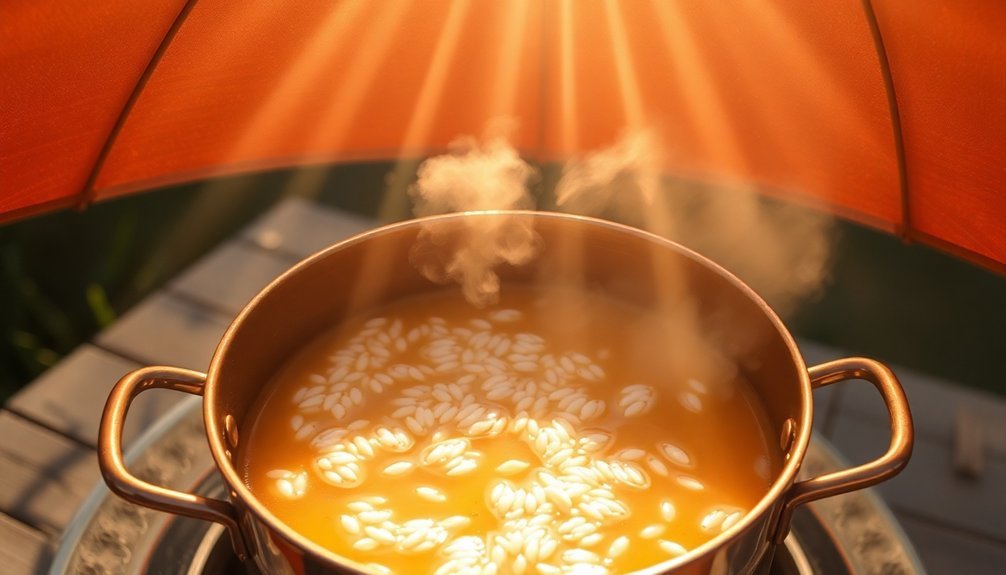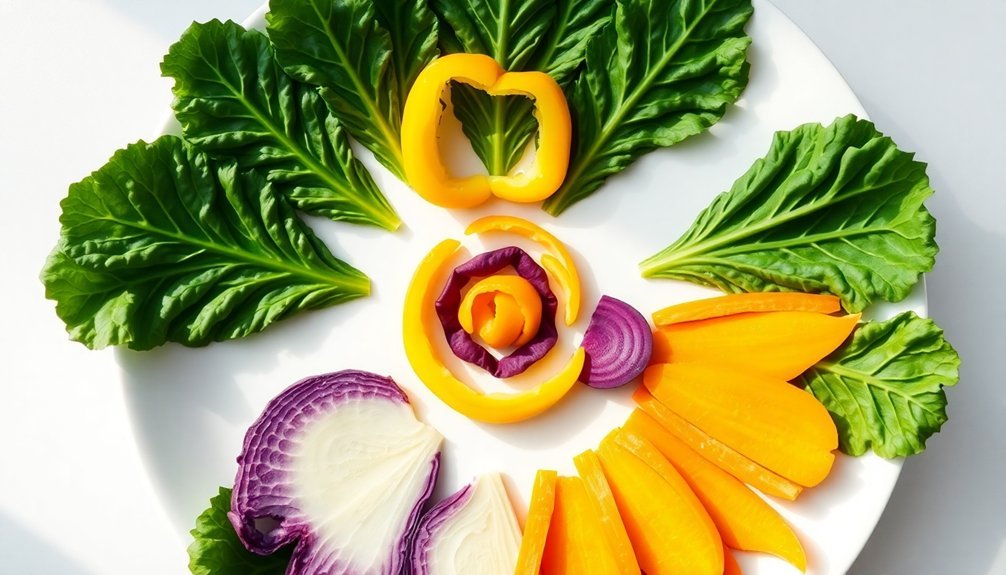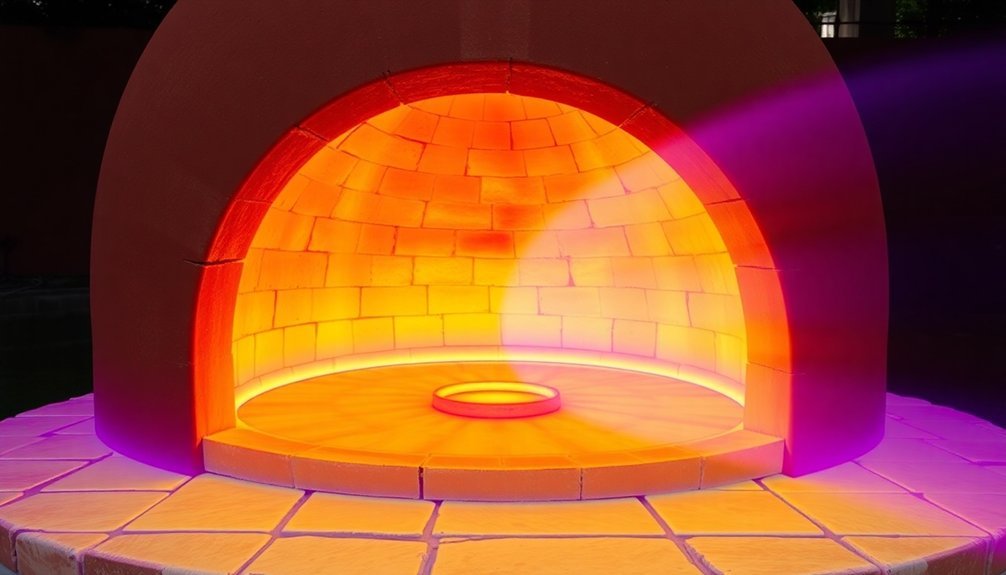Sunlight doesn't directly create the creaminess in your risotto – it's all about how the heat interacts with the rice's high starch content. When you use a solar cooker, concentrated sunlight can reach temperatures between 65°C to 400°C, which is perfect for slowly releasing the starches from Arborio or Carnaroli rice. You'll achieve the signature creamy texture through proper stirring technique (mantecatura) and gradual stock absorption, just like on a stovetop. Proper equipment setup, including black cooking vessels and reflective surfaces, guarantees even heat distribution. The sun's consistent warmth offers a sustainable way to master this classic Italian dish.
The Science Behind Solar Cooking

The science behind solar cooking relies on three fundamental principles: concentrating sunlight, converting light to heat, and trapping that heat effectively.
To concentrate sunlight, you'll need highly reflective surfaces like mirrors or foil that direct and focus the sun's rays onto a small cooking area. These surfaces can amplify sunlight by several orders of magnitude, creating the intense heat needed for cooking your risotto. Specialized designs can achieve temperatures of 65°C to 400°C with proper sunlight concentration.
The concentrated light then hits your cooking vessel, where the second principle comes into play. Your pot or pan, ideally matte black in color, acts as a receiver that converts light energy into heat through absorption. The darker the surface, the better it'll absorb and conduct heat to cook your food evenly. To maximize this conversion, you'll want materials specifically designed to absorb and retain heat efficiently.
The final principle involves trapping this generated heat. You'll use a clear plastic cover or glazing that creates a greenhouse effect, preventing heat from escaping while letting sunlight in. Proper insulation maintains stable cooking temperatures, ensuring your risotto cooks thoroughly.
This three-step process harnesses solar energy effectively, making it possible to cook delicious meals using only the sun's power.
Essential Equipment for Solar Risotto
Now that you understand how solar cooking works, let's outfit your kitchen with the right tools for making solar risotto.
You'll need two primary vessels: a wide, heavy-bottomed pan for the risotto itself and a separate pan for keeping your stock warm. The risotto pan should ideally be a saucier-style vessel with sloped sides, made from stainless steel or a nonstick material for even heat distribution. For customers in the European Union, risotto equipment orders are currently suspended due to regulatory changes.
For precise cooking control and proper technique, you'll want these essential tools:
- A long-handled wooden spoon or silicone spatula for constant stirring without scratching your cookware
- A sturdy ladle for adding warm stock in measured amounts
- A cheese grater for freshly grating Parmesan or other hard cheeses
- Accurate measuring cups and spoons for proper ingredient ratios
- A sharp knife and cutting board for preparing aromatics
Your stock pan should be large enough to hold about three times the volume of rice you're using, as risotto requires frequent additions of warm liquid.
Remember that your stirring utensil should be comfortable to hold, as you'll be using it continuously throughout the cooking process.
Preparing Your Solar Cooking Station

Position your solar oven in direct sunlight, ensuring it faces the ideal direction while keeping the reflective flap propped at the right angle to maximize heat capture.
You'll need to check and adjust the cooker's position every 20 minutes to maintain consistent heat as the sun moves across the sky.
Double-check that your black cooking pot is centered inside the well-insulated cooking area, which should be lined with black construction paper and sealed properly with clear plastic wrap to retain heat effectively. Create a strong layer of insulation using newspapers around the edges of your cooking area to prevent heat from escaping.
Essential Equipment Setup
Setting up your solar cooking station begins with gathering the essential equipment needed for a successful risotto preparation.
You'll need a solar cooker constructed from corrugated cardboard and lined with aluminum foil strips to maximize sunlight reflection. The cooking vessel is vital – choose a dark-colored pot or pan, preferably black metal or cast iron, as these materials absorb heat effectively.
To maintain consistent temperature for your risotto, you'll want to guarantee proper insulation and heat retention:
- Position a wire rack or stand inside your cooker to elevate the pot and minimize heat loss
- Use a high-temperature baking bag around your cooking vessel to trap heat
- Install an oven thermometer to monitor cooking temperature accurately
- Place a transparent glass or plastic glazing on top to create a greenhouse effect
- Add insulation between boxes using dry plant fibers or crumpled newspaper
Don't forget to include reflective panels made from Mylar or additional aluminum foil to direct more sunlight toward your cooking vessel.
Keep pot holders nearby for safe handling, and consider using clothespins to secure any loose flaps that might cast unwanted shadows on your cooking area.
Positioning Your Solar Cooker
Successful solar cooking hinges on finding the perfect spot to position your cooker. You'll need a dry, level surface with unobstructed access to direct sunlight throughout your cooking time. Make certain there aren't any trees, buildings, or other structures that could cast shadows on your cooking area.
To achieve the perfect risotto, you'll need to orient your cooker based on your planned mealtime. For lunch, position the front panel facing east to catch mid-morning sun. If you're cooking for dinner, face it westward for afternoon rays. For all-day cooking, align the cooker toward where the sun will be at noon or early afternoon, and adjust its position every couple of hours.
Don't forget to optimize your reflective components. Adjust the front flap or reflector to direct maximum sunlight onto your pot without creating any blockages. You can use sticks or rods to achieve the ideal angle.
If you're using a parabolic cooker, make sure your risotto pot sits precisely at the focal point. Remember to wear sunglasses when working with parabolic cookers, as the reflected light can be intense.
Timing and Weather Considerations
Creating perfect risotto requires careful attention to timing and a thoughtful selection of seasonal ingredients.
You'll need to dedicate about 18 minutes to the cooking process, starting from when you add the first ladle of stock. During this time, you'll want to stir continuously to maintain even heat distribution and achieve that signature creamy texture.
The cooking process follows distinct stages, beginning with the soffritto and moving through the tostatura, where you'll toast the rice to create a protective shell around each grain.
You'll then add wine to deglaze, followed by gradually incorporating stock until the rice reaches the perfect al dente consistency.
Each season offers unique ingredients that'll enhance your risotto:
- Spring brings vibrant asparagus, artichokes, and tender peas
- Summer offers sun-ripened tomatoes and late-season pumpkin
- Autumn welcomes earthy porcini mushrooms and hearty legumes
- Winter calls for bitter radicchio and robust cheeses
- Year-round, the mantecatura technique remains essential
While sunlight doesn't directly influence risotto's creaminess, your choice of seasonal ingredients and attention to proper timing will guarantee a perfectly executed dish.
Rice Selection Matters

You'll quickly discover that Arborio's high-starch grain structure creates the signature creamy texture that makes risotto so distinctive.
While standard white rice won't achieve the same results, Arborio isn't your only option for authentic risotto.
Premium alternatives like Carnaroli and Vialone Nano offer superior texture control and enhanced flavor absorption, making them worth seeking out for your next risotto adventure.
Arborio's Starchy Grain Structure
The unique structure of Arborio rice makes it the perfect foundation for authentic Italian risotto. You'll find this oval-shaped grain, measuring about a quarter-inch long, packed with amylopectin starch – the key ingredient that creates risotto's signature creamy texture.
When you're stirring and slowly cooking Arborio rice, you're actually helping release this special starch into your dish.
What sets Arborio apart from other rice varieties is its high amylopectin and low amylose content. This unique balance allows the rice to:
- Release abundant starch during cooking, creating a naturally thick sauce
- Maintain its firm, chewy center while developing a creamy exterior
- Absorb significant amounts of liquid without becoming mushy
- Hold its shape throughout the cooking process
- Deliver that distinctive al dente texture in the finished dish
You'll notice that as you stir and add liquid gradually, the rice's starchy exterior breaks down while the core remains intact.
This process, combined with Arborio's specific grain structure, transforms your dish into the luxuriously creamy risotto that Italian cuisine is famous for.
Beyond Basic White Rice
While Arborio rice might be the most widely recognized risotto grain, authentic Italian cuisine offers several exceptional alternatives that can elevate your dish.
You'll find that superfino-grade varieties like Carnaroli, Vialone Nano, and Baldo each bring unique characteristics to your risotto.
If you're concerned about overcooking, Carnaroli is your best choice. Its plump grains hold their shape better than Arborio and withstand longer cooking times, making it a favorite among professional chefs, especially in Milan.
For seafood risottos, you'll want to take into account Vialone Nano, a stubby grain that's particularly popular in the Veneto region. It releases starch quickly, creating that coveted creamy consistency while maintaining a pleasant chewiness.
Don't overlook Baldo, a hybrid variety that combines Arborio's qualities with excellent texture retention. You'll notice it maintains its structure throughout cooking while delivering rich flavor.
Each of these varieties belongs to Italy's highest rice grade, superfino, but they'll give you distinctly different results in your cooking. Your choice of grain can transform a basic risotto into an authentic Italian masterpiece.
Premium Short-Grain Alternatives
Beyond traditional Italian varieties, several premium short-grain alternatives offer compelling options for creating exceptional risotto dishes.
You'll find that short-grain brown rice, while requiring longer cooking times and pre-soaking, delivers a nutrient-rich twist on classic risotto. Sushi rice proves particularly effective, thanks to its high starch content and firm texture – just don't rinse it before cooking to maintain those vital starches.
When exploring premium alternatives, consider these key options:
- Short-grain brown rice brings fuller nutrition and a distinct nutty flavor, though you'll need to soak it for at least 3 hours.
- Carnaroli rice offers superior shape retention and reheating qualities compared to standard Arborio.
- Vialone Nano, grown in Veneto, creates an exceptionally full-bodied texture.
- Baldo and Maratelli varieties maintain perfect al dente texture while releasing ample starch.
- Sushi rice serves as a practical alternative, providing similar creaminess when properly prepared.
Each alternative brings its own characteristics to your risotto, but they all share the essential high amylopectin content that creates that signature creamy texture you're looking for.
Choose based on your specific needs – whether it's nutrition, texture, or convenience.
Managing Temperature With Sunlight
Managing temperature effectively in solar cooking requires understanding how to control sunlight exposure and heat retention. To achieve the perfect creamy risotto, you'll need to position your solar cooker directly facing the sun, especially during peak hours. For best results, angle your reflectors to maximize sunlight concentration on your cooking vessel.
You can control the temperature by adjusting several components of your solar cooker. Remove or add reflectors, modify the heat seal tightness, and use lids strategically to maintain the ideal temperature for your risotto. You'll want to monitor the inside temperature with an oven thermometer and refocus the cooker periodically, particularly during longer cooking sessions.
Choose your cookware carefully – opt for thin-walled, dark-colored pots with tight-fitting lids. These characteristics enhance heat absorption and retention, essential for achieving the perfect risotto consistency. Short, wide pots ensure even cooking, while materials like glass, ceramic, or stainless steel provide safe, nontoxic surfaces.
Remember that environmental factors like wind, clouds, and humidity can affect your cooker's performance, so you may need to adjust your cooking strategy based on local conditions.
Stirring Techniques for Solar Cooking

Stirring risotto in a solar cooker requires a modified approach compared to traditional stovetop methods. You'll need to adapt your stirring technique to work with the solar cooker's unique heating pattern and the sun's movement throughout the day.
Since you're rotating the cooker every 30 minutes to follow the sun's path, you can coordinate your stirring schedule with these adjustments.
To achieve the perfect creamy consistency in your solar-cooked risotto, follow these essential stirring techniques:
- Time your stirring intervals with the solar cooker's 30-minute rotation schedule to maintain consistent heat distribution.
- Keep the lid closed between stirring sessions to preserve heat, as the cooking temperature relies on trapped solar energy.
- Position your pot in the focal point of the reflectors before each stirring session to maximize heat exposure.
- Use insulated pot holders when stirring, as the black-painted cooking pot will be extremely hot from absorbing solar energy.
- Adjust stirring frequency based on the sun's intensity – more frequent stirring on bright days, less on cloudy ones.
Remember to preheat your solar cooker for 30 minutes before adding the risotto, and monitor the cooking temperature by checking how quickly the liquid absorbs between stirs.
Liquid Absorption Under Solar Heat
Understanding liquid absorption when solar cooking risotto requires careful attention to both heat levels and timing. Your solar cooker converts UV rays into infrared radiation, which provides the consistent heat needed for proper starch breakdown in the rice.
When you're using a solar cooker, the steady temperature helps the rice's amylose and amylopectin starches absorb liquid evenly. You don't need to add liquid gradually as traditional methods suggest. Instead, you can add larger quantities at once, making sure to reserve some for the final stage of cooking.
The key is ensuring all rice grains are covered with liquid and maintaining proper heat through your solar cooker's insulation system. The dark, matte surface of your cooking pot will absorb solar energy efficiently, while the glass lid or clear plastic covering traps heat effectively.
On cloudy days, you'll need to adjust your cooking time, but don't worry – proper heat retention mechanisms in your solar cooker will maintain suitable temperatures for risotto cooking. The combination of consistent heat and proper liquid coverage allows the rice starches to break down gradually, creating that signature creamy texture you're looking for.
Adding Seasonal Ingredients

You'll find that summer tomatoes bring a vibrant acidity and natural sweetness to your risotto, creating a bright contrast to the creamy base.
Fresh herbs like basil, thyme, and parsley can transform your dish with their aromatic qualities and distinct flavors.
The addition of seasonal vegetables like asparagus in spring or squash in autumn adds layers of texture and depth, making your risotto a true reflection of the season's bounty.
Summer Tomatoes Add Brightness
Fresh summer tomatoes transform a classic Italian risotto into a vibrant, seasonal delight. When you're selecting tomatoes for your risotto, choose ripe, juicy ones from your local farmers market or garden during peak season. These sun-ripened beauties add both brightness and depth to the creamy Arborio rice base, creating a perfect balance of flavors.
Start by sautéing onions and garlic until soft, then add your Arborio rice and white wine. As you ladle in warm broth, you'll notice the rice releasing its natural starches, creating that signature creamy texture. The cubed tomatoes will slowly release their juices, infusing the dish with fresh, seasonal flavor.
- Use larger, ripe tomatoes instead of cherry varieties for better flavor distribution
- Add torn fresh basil at the end for an aromatic finish
- Incorporate Parmigiano or Pecorino cheese for extra richness
- Consider adding seafood like shrimp or scallops for protein
- Save leftovers to stuff and bake tomatoes the next day
Finish your risotto with a pat of butter and freshly grated cheese, ensuring it maintains a loose, creamy consistency that's perfectly al dente.
Fresh Herbs Enhance Flavor
The magic of fresh herbs transforms an ordinary risotto into an aromatic masterpiece. You'll find that herbs like parsley, basil, thyme, and sage each bring their unique character to your dish.
When you're cooking, you can sauté these herbs with garlic and onion to release their essential oils and intensify their flavors.
For maximum impact, you'll want to finely chop your herbs before adding them to the risotto. Basil contributes a sweet, aromatic profile, while thyme offers a fragrant aroma with a lively bite. If you're looking to balance the richness of Parmesan cheese, parsley's fresh, herbaceous notes work wonderfully.
You can also create herb-infused butter using rosemary, thyme, sage, or marjoram for an extra layer of flavor.
Remember to add delicate herbs towards the end of cooking to preserve their brightness and aroma. You're not limited to using just one herb – feel free to mix and match to create your perfect flavor combination.
Whether you're using oregano for its distinctive taste or garlic chives for their mild allium notes, fresh herbs will complement your risotto's creamy texture while adding depth and complexity to every bite.
Seasonal Vegetables Create Depth
Beyond fresh herbs, seasonal vegetables bring distinctive character and richness to your risotto throughout the year. As autumn arrives, you'll find pumpkin paired with rosemary creating hearty comfort, while mushrooms, especially chanterelles, add an earthy depth.
Winter calls for tenderstem broccoli and frozen peas, with sausage and raspadura cheese bringing warmth to your dish.
Spring ushers in nature's bounty, perfect for lighter, vibrant risottos. You'll want to blanch your vegetables in salted water before incorporating them into your creation. The season's fresh ingredients create a colorful symphony in your pot.
Here's what you can expect from each season:
- Spring: Asparagus, fresh peas, zucchini, and yellow squash create delicate flavors
- Summer: Artichokes paired with pecorino cheese offer unique profiles
- Fall: Radicchio and gorgonzola combine for rich, complex tastes
- Winter: Hearty ingredients like sausage and broccoli add substance
- Year-round: Transform leftovers into new dishes like supplì or arancini
Don't hesitate to raid your pantry or fridge for odds and ends of guanciale or pancetta – these ingredients can elevate your risotto's depth unexpectedly.
Solar Heat Versus Stovetop Methods
Traditional cooking methods for risotto clearly favor stovetop preparation over solar heat, which isn't suitable for this classic Italian dish.
Solar cooking lacks the precise temperature control and even heating distribution that's vital for perfect risotto, making it impractical and potentially disastrous for your dish.
You'll need the stovetop's consistent heat to properly execute the essential steps of risotto-making. Start with the soffritto, sautéing your onions to create a flavorful base, then move on to the tostatura, where you'll toast the rice to develop its nutty aroma and prepare it for starch release.
The stovetop allows you to maintain the perfect temperature while gradually adding hot broth and stirring constantly.
Your risotto's signature creaminess depends on careful temperature control and immediate adjustments that only stovetop cooking can provide.
You'll keep your stock simmering gently nearby, adding it gradually while stirring to achieve that perfect al dente texture.
The final mantecatura step, where you'll incorporate butter and Parmigiano-Reggiano, requires the stovetop's reliable heat to create that irresistibly smooth finish.
Serving Your Sun-Cooked Risotto

Despite the previous discussion advising against solar cooking, if you've chosen to prepare sun-cooked risotto, serving it properly remains essential for the best dining experience.
You'll want to serve your risotto immediately on warmed plates to maintain its signature creamy texture. While the dish stands beautifully on its own, you can elevate it with thoughtfully chosen accompaniments.
For a complete meal, consider pairing your risotto with these complementary elements:
- Pan-seared scallops or garlic shrimp for an elegant seafood option
- Braised lemon chicken or baked meatballs for heartier protein choices
- Roasted vegetables like carrots, broccolini, or acorn squash for added nutrition
- Fresh herbs and additional Parmesan cheese for customizable finishing touches
- Balsamic glaze or garlic sauce for extra flavor depth
When serving, make final adjustments to seasoning and consistency just before plating.
Your risotto can function as either a main dish or sophisticated side, depending on your chosen accompaniments. Remember to provide extra grated cheese at the table, allowing guests to customize their portions to taste.
Frequently Asked Questions
Can Solar-Cooked Risotto Develop the Same Golden Crust as Stovetop Versions?
No, you won't achieve the same golden crust in solar-cooked risotto as stovetop versions. The lack of direct heat, constant stirring, and limited temperature control prevents the essential Maillard reaction for crust formation.
Does Cooking Risotto in Sunlight Affect Its Nutritional Content?
You won't see changes in nutritional content from cooking risotto in sunlight. The nutrients in your ingredients remain stable, as the cooking method – not exposure to sunlight – determines the final nutritional profile.
How Do Different Altitudes Impact Solar Risotto Cooking Times?
You'll cook your risotto faster at higher altitudes due to increased solar radiation. At 1000+ meters, you'll see up to 50% more efficiency, but you'll need to adjust your cooker more frequently for best results.
Can Moonlight or Artificial Outdoor Lighting Cook Risotto Effectively?
No, you can't cook risotto with moonlight or artificial outdoor lighting. They don't provide enough heat energy for cooking. You'll need a proper heat source like a stovetop to make creamy, properly cooked risotto.
Will Solar-Cooked Risotto Maintain Its Texture When Reheated Indoors?
Yes, you'll find that solar-cooked risotto maintains its texture when reheated indoors. Just use gentle heat, stir constantly, and add a splash of broth while reheating to preserve its original creamy consistency.
In Summary
You've discovered a unique way to create creamy risotto using the sun's gentle, consistent heat. While it takes longer than stovetop cooking, solar energy slowly releases the rice's starches, creating that signature silky texture. You'll find this method not only saves energy but also infuses your dish with a subtle depth of flavor. Remember to choose bright, clear days for the best results with your solar risotto.





Leave a Reply